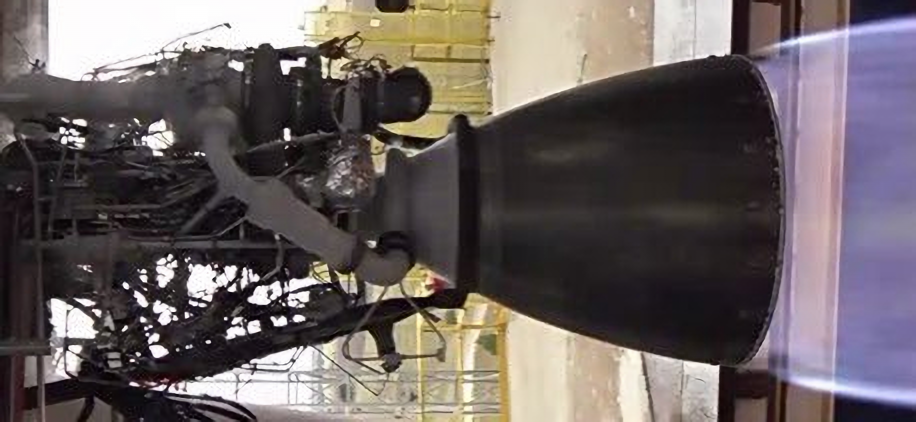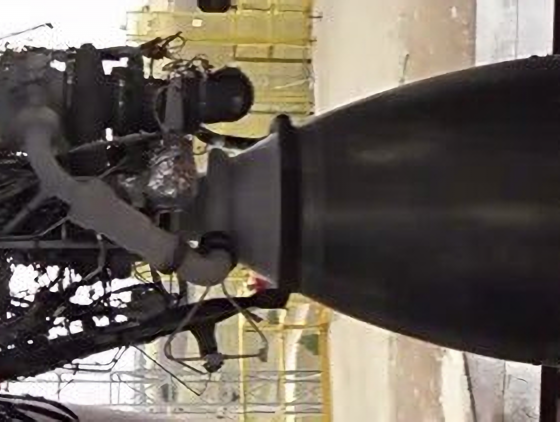

News
SpaceX crushes rocket engine world record during Raptor test
CEO Elon Musk has revealed that SpaceX crushed a global rocketry record during a recent Raptor engine test, pushing the crucial Starship component past years-old performance targets.
On August 17th, the SpaceX CEO unexpectedly released a photo of a Raptor test and a corresponding graph showing the engine’s chamber pressure, confirming that the company had successfully pushed the engine to record-breaking levels. Musk says that an unspecified Raptor – possibly serial number 39 (SN39) – briefly reached a main combustion chamber pressure of 330 bar (~4800 psi) during a controlled burn – and remained intact after shutdown.
Outside of subscale laboratory tests, the highest main combustion chamber known to full-scale, orbital-class rocketry was achieved by the Soviet Union in the 1980s with the RD-701 engine. Although the exceptionally unique engine was canceled before it could be used, it reportedly reached pressures of 290-300 bar in one mode of operation. Now, however, SpaceX and its Raptor engine appear to be the new world record holders – and by a huge margin.

Raptor’s new crown comes roughly 18 months after Elon Musk revealed that the engine had beaten the Soviet RD-270 full-flow staged combustion (FFSC) with a higher sustained chamber pressure (~257 bar vs 255 bar). A few days later, the same Raptor went even further, cresting the Russian RD-180 engine’s 257 bar operating pressure with a peak of 268 bar. Still, SpaceX needed 6-12 more months to refine Raptor into an engine capable of operating even close to those pressures for more than ~10 seconds. In July and August 2019, Raptor engine SN6 flew twice on Starhopper, culminating in a ~60-second, 150-meter hop that ended with the engine nearly destroying itself seconds before landing.
Almost exactly one year later, Raptor SN27 launched on Starship SN5 on the same 150m trajectory and appeared to perform flawlessly. Exhibiting barely a stutter or flare, SN27 never came close to the flamethrower-like death throes Raptor SN6 suffered in August 2019. In short, SpaceX continued to do what SpaceX does best, continuously refining rough prototypes into increasingly polished end products.
Originally revealed in 2016 as a methane/oxygen full-flow staged combustion engine with an operating combustion chamber pressure of 300 bar (4350 psi), Raptor’s August 17th achievement means that SpaceX has already exceeded one of its performance goals. Of course, combustion chamber pressure is significant but still far less important than engine longevity, burn duration limits, and reusability in the context of Starship. SpaceX likely wouldn’t be pushing the envelope of chamber pressure if it wasn’t confident about Raptor’s many other important attributes, but it’s still unknown if Raptor has ever burned for longer than ~90 seconds.
Regardless, if Raptor can actually sustain chamber pressures of 330 bar without damaging itself, the milestone could mean that SpaceX has already boosted Raptor’s maximum thrust from ~200 metric tons to ~225 metric tons (440,000-500,000 lbf. For Starship and Super Heavy, that 10% increase in thrust could easily translate to a 5-10% increase in payload to orbit per launch.

To reach orbit, though, Raptor still has a ways to go. For Super Heavy to be able to complete a normal launch, SpaceX will need to dramatically expand Raptor production (~31 engines per booster) and ensure that Raptor can reliably operate for 3-5+ minutes and reignite multiple times in flight. For Starship, SpaceX needs – at the minimum – to mature Raptor until it can burn continuously for 5-10 minutes to reach orbit. The company will likely also need to finish developing a custom vacuum-optimized version of Raptor for efficient orbital Starship flights.
Given just how quiet SpaceX is about most Raptor milestones, there’s a chance the company has already made substantial progress along those lines. For example, Starship SN8 – already well on its way to completion – will likely be the first prototype to fly with three Raptor engines and will need the ability to stop and start those engines in-flight to perform full-fidelity 20 km (~12.5 mi) launch and landing tests. Even just sustaining 330 bar for 10-100+ seconds without destroying the engine is likely several Raptor iterations away. Still, given SpaceX’s track record, all of those milestones are likely just a matter of time and perseverance.
Check out Teslarati’s Marketplace! We offer Tesla accessories, including for the Tesla Cybertruck and Tesla Model 3.

News
Tesla starts showing how FSD will change lives in Europe
Local officials tested the system on narrow country roads and were impressed by FSD’s smooth, human-like driving, with some calling the service a game-changer for everyday life in areas that are far from urban centers.

Tesla has launched Europe’s first public shuttle service using Full Self-Driving (Supervised) in the rural Eifelkreis Bitburg-Prüm region of Germany, demonstrating how the technology can restore independence and mobility for people who struggle with limited transport options.
Local officials tested the system on narrow country roads and were impressed by FSD’s smooth, human-like driving, with some calling the service a game-changer for everyday life in areas that are far from urban centers.
Officials see real impact on rural residents
Arzfeld Mayor Johannes Kuhl and District Administrator Andreas Kruppert personally tested the Tesla shuttle service. This allowed them to see just how well FSD navigated winding lanes and rural roads confidently. Kruppert said, “Autonomous driving sounds like science fiction to many, but we simply see here that it works totally well in rural regions too.” Kuhl, for his part, also noted that FSD “feels like a very experienced driver.”
The pilot complements the area’s “Citizen Bus” program, which provides on-demand rides for elderly residents who can no longer drive themselves. Tesla Europe shared a video of a demonstration of the service, highlighting how FSD gives people their freedom back, even in places where public transport is not as prevalent.
What the Ministry for Economic Affairs and Transport says
Rhineland-Palatinate’s Minister Daniela Schmitt supported the project, praising the collaboration that made this “first of its kind in Europe” possible. As per the ministry, the rural rollout for the service shows FSD’s potential beyond major cities, and it delivers tangible benefits like grocery runs, doctor visits, and social connections for isolated residents.
“Reliable and flexible mobility is especially vital in rural areas. With the launch of a shuttle service using self-driving vehicles (FSD supervised) by Tesla in the Eifelkreis Bitburg-Prüm, an innovative pilot project is now getting underway that complements local community bus services. It is the first project of its kind in Europe.
“The result is a real gain for rural mobility: greater accessibility, more flexibility and tangible benefits for everyday life. A strong signal for innovation, cooperation and future-oriented mobility beyond urban centers,” the ministry wrote in a LinkedIn post.
News
Tesla China quietly posts Robotaxi-related job listing
Tesla China is currently seeking a Low Voltage Electrical Engineer to work on circuit board design for the company’s autonomous vehicles.

Tesla has posted a new job listing in Shanghai explicitly tied to its Robotaxi program, fueling speculation that the company is preparing to launch its dedicated autonomous ride-hailing service in China.
As noted in the listing, Tesla China is currently seeking a Low Voltage Electrical Engineer to work on circuit board design for the company’s autonomous vehicles.
Robotaxi-specific role
The listing, which was shared on social media platform X by industry watcher @tslaming, suggested that Tesla China is looking to fill the role urgently. The job listing itself specifically mentions that the person hired for the role will be working on the Low Voltage Hardware team, which would design the circuit boards that would serve as the nervous system of the Robotaxi.
Key tasks for the role, as indicated in the job listing, include collaboration with PCB layout, firmware, mechanical, program management, and validation teams, among other responsibilities. The role is based in Shanghai.
China Robotaxi launch
China represents a massive potential market for robotaxis, with its dense urban centers and supportive policies in select cities. Tesla has limited permission to roll out FSD in the country, though despite this, its vehicles have been hailed as among the best in the market when it comes to autonomous features. So far, at least, it appears that China supports Tesla’s FSD and Robotaxi rollout.
This was hinted at in November, when Tesla brought the Cybercab to the 8th China International Import Expo (CIIE) in Shanghai, marking the first time that the autonomous two-seater was brought to the Asia-Pacific region. The vehicle, despite not having a release date in China, received a significant amount of interest among the event’s attendees.
Elon Musk
Elon Musk and Tesla AI Director share insights after empty driver seat Robotaxi rides
The executives’ unoccupied tests hint at the rapid progress of Tesla’s unsupervised Robotaxi efforts.

Tesla CEO Elon Musk and AI Director Ashok Elluswamy celebrated Christmas Eve by sharing personal experiences with Robotaxi vehicles that had no safety monitor or occupant in the driver’s seat. Musk described the system’s “perfect driving” around Austin, while Elluswamy posted video from the back seat, calling it “an amazing experience.”
The executives’ unoccupied tests hint at the rapid progress of Tesla’s unsupervised Robotaxi efforts.
Elon and Ashok’s firsthand Robotaxi insights
Prior to Musk and the Tesla AI Director’s posts, sightings of unmanned Teslas navigating public roads were widely shared on social media. One such vehicle was spotted in Austin, Texas, which Elon Musk acknowleged by stating that “Testing is underway with no occupants in the car.”
Based on his Christmas Eve post, Musk seemed to have tested an unmanned Tesla himself. “A Tesla with no safety monitor in the car and me sitting in the passenger seat took me all around Austin on Sunday with perfect driving,” Musk wrote in his post.
Elluswamy responded with a 2-minute video showing himself in the rear of an unmanned Tesla. The video featured the vehicle’s empty front seats, as well as its smooth handling through real-world traffic. He captioned his video with the words, “It’s an amazing experience!”
Towards Unsupervised operations
During an xAI Hackathon earlier this month, Elon Musk mentioned that Tesla owed be removing Safety Monitors from its Robotaxis in Austin in just three weeks. “Unsupervised is pretty much solved at this point. So there will be Tesla Robotaxis operating in Austin with no one in them. Not even anyone in the passenger seat in about three weeks,” he said. Musk echoed similar estimates at the 2025 Annual Shareholder Meeting and the Q3 2025 earnings call.
Considering the insights that were posted Musk and Elluswamy, it does appear that Tesla is working hard towards operating its Robotaxis with no safety monitors. This is quite impressive considering that the service was launched just earlier this year.








